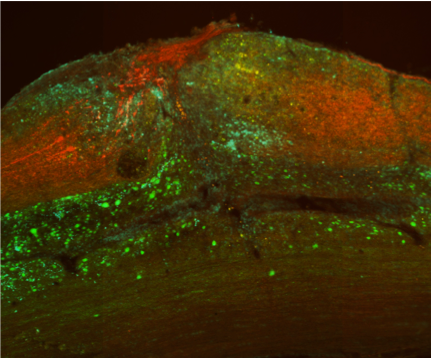
Understanding the mechanisms that lead to spinal regeneration, in addition to identifying possible therapeutic targets that could be used to treat traumatic lesions of the central nervous system, are highly relevant topics in biomedical research.
In an article recently published in the EMBO Journal, the result of a collaboration between researchers from the Institute for Bioengineering of Catalonia (IBEC) and Imperial College London, researchers analysed the regenerative capacity of the sensory system of dorsal root ganglia (DRG). The reason for which is that these neurons have an axonal branch in the central nervous system and another in the peripheral nervous system, which come from a single cell body, making it possible to study the mechanisms involved in the regenerative capacity of the peripheral nerves against the incapacity of the central nervous system. “Lesions of the peripheral nervous system respond differently to those of the central nervous system. Identifying differences in the cellular response in both branches of the sensory system allows us to identify possible targets for treating spinal cord injuries”, says Professor Di Giovanni, who headed the investigation.
The researchers found that lesions of the peripheral branch, but not of the central branch, induces an increase in calcium that, in turn, activated a cascade of biochemical reactions that ended up inactivating an enzyme called HDAC3. This enzyme is an epigenetic regulator and through massive sequencing studies and bioinformatics and functional analyses, researchers were able to identify that it was silencing the expression of genes that are essential for axonal regeneration. “The therapeutic inhibition of the HDAC3 enzyme in animal models of spinal cord injury allows for an increase in regenerative capacity after lesions of the central nervous system, thus opening the door to future treatments for patients with spinal cord injuries”, concluded Dr Arnau Hervera, lead author of the article.
Finally, researchers proved that the genetic or pharmacological inhibition of the HDAC3 enzyme also causes regenerative growth in a model of spinal cord injury in mice, thus identifying a new therapeutic target for treating spinal cord injuries.
The study was led by Dr Arnau Hervera and carried out between the laboratories of Professor José Antonio del Río at IBEC and Professor Simone di Giovanni at Imperial College London. Both laboratories had already collaborated in a similar way for the 2018 publication in Nat Cell Bio, also led by Dr Arnau Hervera.
Article referenciat: Arnau Hervera, Luming Zhou, Ilaria Palmisano, Eilidh McLachlan, Guiping Kong, Thomas Hutson, Matt C Danzi, Vance P. Lemmon, John L. Bixby, Andreu Matamoros-Angles, Kirsi Forsberg, Francesco De Virgiliis, Dina P. Matheos, Janine Kwapis, Marcelo A. Wood, Radhika Puttagunta, José Antonio del Río, Simone Di Giovanni (2019) PP4‐dependent HDAC3 dephosphorylation discriminates between axonal regeneration and regenerative failure. EMBO, doi: 10.15252/embj.2018101032





